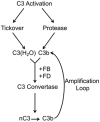Evolution of the complement system: from defense of the single cell to guardian of the intravascular space
- PMID: 27782327
- PMCID: PMC5108576
- DOI: 10.1111/imr.12474
Evolution of the complement system: from defense of the single cell to guardian of the intravascular space
Abstract
The complement system is an evolutionarily ancient component of immunity that revolves around the central component C3. With the recent description of intracellular C3 stores in many types of human cells, our view of the complement system has expanded. In this article, we hypothesize that a primitive version of C3 comprised the first element of the original complement system and initially functioned intracellularly and on the membrane of single-celled organisms. With increasing specialization and multicellularity, C3 evolved a secretory capacity that allowed it to play a protective role in the interstitial space. Upon development of a pumped circulatory system, C3 was synthesized in large amounts and secreted by the liver to protect the intravascular space. Recent discoveries of intracellular C3 activation, a C3-based recycling pathway and C3 being a driver and programmer of cell metabolism suggest that the complement system utilizes C3 to guard not only extracellular but also the intracellular environment. We predict that the major functions of C3 in all four locations (i.e. intracellular, membrane, interstitium and circulation) are similar: opsonization, membrane perturbation, triggering inflammation, and metabolic reprogramming.
Keywords: C3; C3 recycling; evolution; intracellular complement system.
© 2016 John Wiley & Sons A/S. Published by John Wiley & Sons Ltd.
Figures






References
-
- Walport MJ. Complement. First of two parts. The New England journal of medicine. 2001;344:1058–1066. - PubMed
-
- Walport MJ. Complement. Second of two parts. The New England journal of medicine. 2001;344:1140–1144. - PubMed
-
- Kemper C, Chan AC, Green JM, Brett KA, Murphy KM, Atkinson JP. Activation of human CD4+ cells with CD3 and CD46 induces a T-regulatory cell 1 phenotype. Nature. 2003;421:388–392. - PubMed
-
- Dempsey PW, Allison ME, Akkaraju S, Goodnow CC, Fearon DT. C3d of complement as a molecular adjuvant: bridging innate and acquired immunity. Science. 1996;271:348–350. - PubMed
Publication types
MeSH terms
Substances
Grants and funding
LinkOut - more resources
Full Text Sources
Other Literature Sources
Miscellaneous

